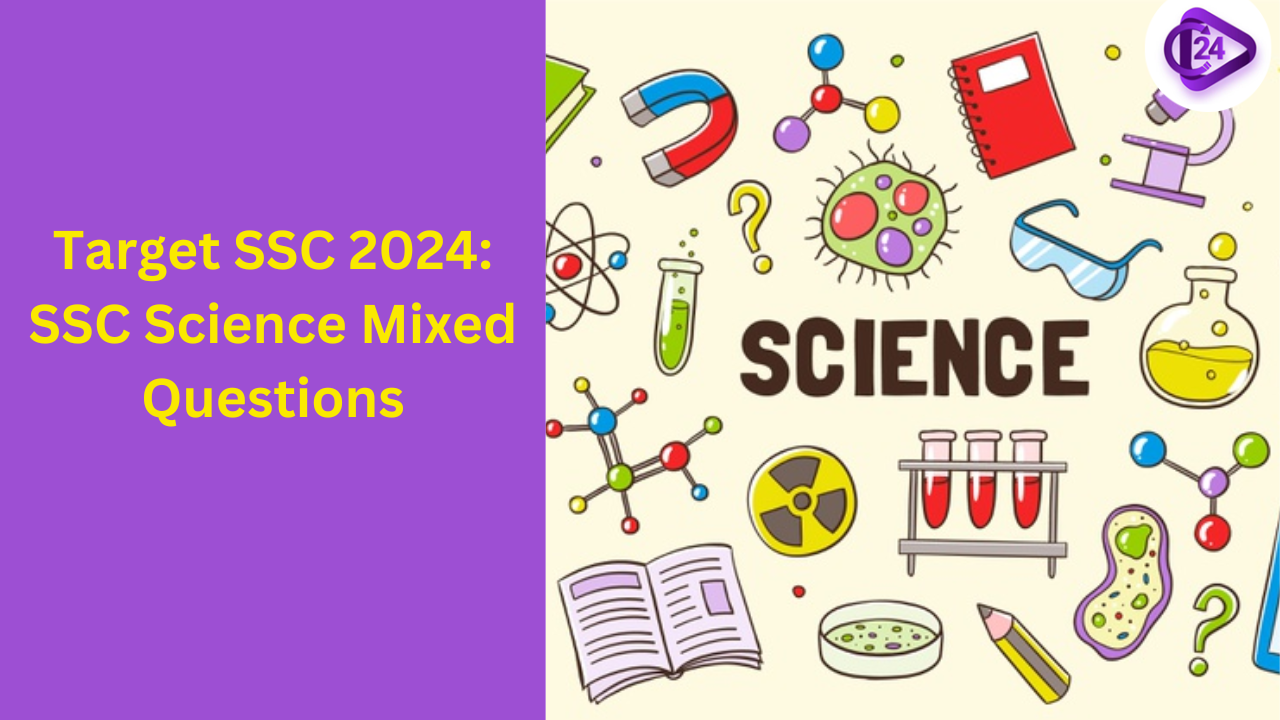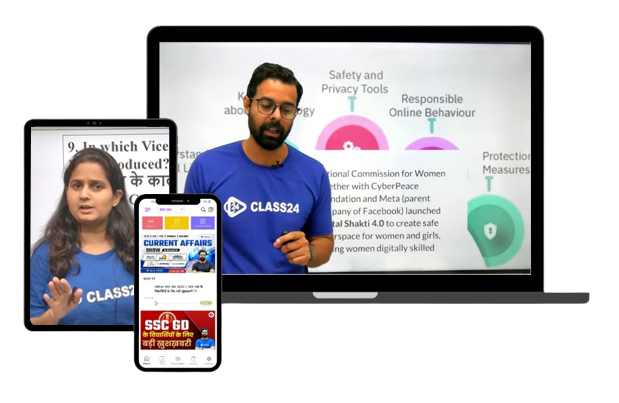Target SSC 2024: SSC Science Mixed Questions Part 1

The Staff Selection Commission (SSC) has already released the SSC calendar for 2024-25 and most of the aspirants must be aware of about this. To keep in mind, we started a series of Target SSC 2024, in which we will share all the important questions for the SSC exams related. In Target SSC 2024: SSC Science Mixed Questions Part 1, we shared the 25 questions for the upcoming SSC exams.
Target SSC 2024: SSC Science Mixed Questions Part 1
Q1. The condition produced by aerial oxidation of fats and oils in foods marked by unpleasant smell and taste is called:
(a) antioxidation
(b) reduction
(c) rancidity
(d) corrosion
Q2. Name the products formed when iron filings are heated with dilute hydrochloric acid
(a) Fe (III) chloride and water
(b) Fe (II) chloride and water
(c) Fe (II) chloride and hydrogen gas
(d) Fe (III) chloride and hydrogen gas
Q3. When green coloured ferrous sulphate crystals are heated, the colour of the crystal changes because
(a) it is decomposed to ferric oxide
(b) it loses water of crystallisation
(c) it forms SO2
(d) it forms SO3
Q4. Which one of the following salts does not contain water of crystallisation?
(a) Blue vitriol
(b) Baking soda
(c) Washing soda
(d) Gypsum
Q5. How many water molecules does hydrated calcium sulphate contain?
(a) 5
(b) 10
(c) 7
(d) 2
Q6. What is observed when a solution of potassium iodide is added to silver nitrate solution?
(a) No reaction takes place
(b) White precipitate of silver iodide is formed
(c) yellow precipitate of Agl is formed
(d) Agl is soluble in water.
Q7. The pH range most conducive for life of fresh water plants and animals is
(a) 6.5 – 7.5
(b) 2.0 – 3.5
(c) 3.5 – 7.0
(d) 9.0 – 10.5
Q8. The opening and closing of the stomatal pore depends upon
(a) oxygen
(b) temperature
(c) water in guard cells
(d) concentration of CO2 in stomata
Q9. Which part of alimentary canal receives bile from the liver?
(a) Stomach
(b) Small intestine
(c) Large intestine
(d) Oesophagus
Q10. Which part of nephron allows the selective reabsorption of useful substances like glucose, amino acids, salts and water into the blood capillaries?
(a) Tubule
(b) Glomerulus
(c) Bowman’s capsule
(d) Ureter
Q11. Single circulation, i.e., blood flows through the heart only once during one cycle of passage through the body, is exhibited by which of the following:
(a) hyla, rana, draco
(b) whale, dolphin, turtle
(c) labeo, chameleon, salamander
(d) hippocampus, exocoetus, anabas
Q12. When a few drops of iodine solution are added to rice water, the solution turns blue- black in colour. This indicates that rice water contains:
(a) fats
(b) complex proteins
(c) starch
(d) simple proteins
Q13. Which of the following events in the mouth cavity will be affected if salivary amylase is lacking in the saliva?
(a) Starch breaking down into sugars.
(b) Proteins breaking down into amino acids.
(c) Absorption of vitamins
(d) Fats breaking down into fatty acids and glycerol
Q14. A feature of reproduction that is common to Amoeba, Yeast and Spirogyra is that
(a) they reproduce asexually
(b) they are all unicellular
(c) they reproduce only sexually
(d) they are all multicellular
Q15. The angle of incidence for a ray of light having zero reflection angle is
(a) 0
(b) 30°
(c) 45°
(d) 90°
Q16. A concave mirror of focal length 20 cm forms an image having twice the size of object. For the virtual position of object, the position of object will be at
(a) 25 cm
(b) 40 cm
(c) 10 cm
(d) At infinity
Q17. If a man’s face is 25 cm in front of concave shaving mirror producing erect image 1.5 times the size of face, focal length of the mirror would be
(a) 75 cm
(b) 25 cm
(c) 15 cm
(d) 60 cm
Q18. The ability of eye lens to adjust its focal length to form a sharp image of the object at varying distances on the retina is called
(a) Power of observation of the eye
(b) Power of adjustment of the eye
(c) Power of accommodation of the eye
(d) Power of enabling of the eye
Q19. Myopia and hypermetropia can be corrected by
(a) Concave and plano-convex lens
(b) Concave and convex lens
(c) Convex and concave lens
(d) Plano-concave lens for both defects.
Q20. Two resistors are connected in series gives an equivalent resistance of 10 Ω. When connected in parallel, gives 2.4 Ω. Then the individual resistance are
(a) Each of 5 Ω
(b) 6 Ω and 4 Ω
(c) 7 Ω and 4 Ω
(d) 8 Ω and 2 Ω
Q21. The effective resistance between A and B is

(a) 4Ω
(b) 6Ω
(c) May be 10 Ω
(d) Must be 10 Ω
Q22. 100 J of heat is produced each second in a 4Ω resistor. The potential difference across the resistor will be:
(a) 30 V
(b) 10 V
(c) 20 V
(d) 25 V
Q23. Inside the magnet, the field lines moves
(a) from north to south
(b) from south the north
(c) away from south pole
(d) away from north pole
Q24. Hydropower plant are located in the
(a) desert area
(b) plain area
(c) hilly terrains
(d) none-of above
Q25. Wind is caused due to
(a) Uneven heating of earth’s surface
(b) Rotation of earth
(c) Local conditions
(d) All of these /ये सभी
Correct Answer:
|
Q1 Ans: (c) |
|
Q2 Ans: (c) |
|
Q3 Ans: (b) |
|
Q4 Ans: (b) |
|
Q5 Ans: (d) |
|
Q6 Ans: (c) |
|
Q7 Ans: (a) |
|
Q8 Ans: (c) |
|
Q9 Ans: (d) |
|
Q10 Ans: (a) |
|
Q11 Ans: (d) |
|
Q12 Ans: (c) |
|
Q13 Ans: (a) |
|
Q14 Ans: (a) |
|
Q15 Ans; (a) |
|
Q16 Ans: (c) |
|
Q17 Ans: (a) |
|
Q18 Ans: (c) |
|
Q19 Ans: (b) |
|
Q20 Ans: (b) |
|
Q21 Ans: (a) |
|
Q22 Ans: (c) |
|
Q23 Ans: (b) |
|
Q24 Ans: (c) |
|
Q25 Ans: (d) |




